Abstract
1. To investigate whether cerebral vasodilatation by itself contributes to the decrease in ventilation as found during brain stem hypoxia the role of cerebral vasodilatation on minute ventilation was investigated in twelve cats anaesthetized with alpha-chloralose-urethane. 2. Cerebral vasodilatation in the medulla oblongata was produced by adding papaverine to the blood perfusing the brain stem. 3. Papaverine at concentrations of 10-35 micrograms per millilitre of blood had an appreciable depressant effect on ventilation. At a concentration of 14.3 micrograms ml-1 the depression in ventilation averaged 0.7 +/- 0.1 l min-1. 4. The ventilatory response to stepwise changes in papaverine concentration could be adequately described with a single exponential function with a time delay. 5. The time constant of the ventilatory response following a step increase in papaverine concentration (134 +/- 15 s) was longer than that of the step decrease (105 +/- 10 s) in concentration (P = 0.034). The time delays of the ventilatory response (88 +/- 21 s and 53 +/- 8 s respectively) were not significantly different (P = 0.126). 6. The ventilatory response to stimulation of the peripheral chemoreceptors by hypoxia and of the central chemoreceptors by hypercapnia was not impaired by papaverine. 7. The results support the hypothesis that cerebral vasodilatation by itself contributes to the decrease in ventilation by brain stem hypoxia.
Full text
PDF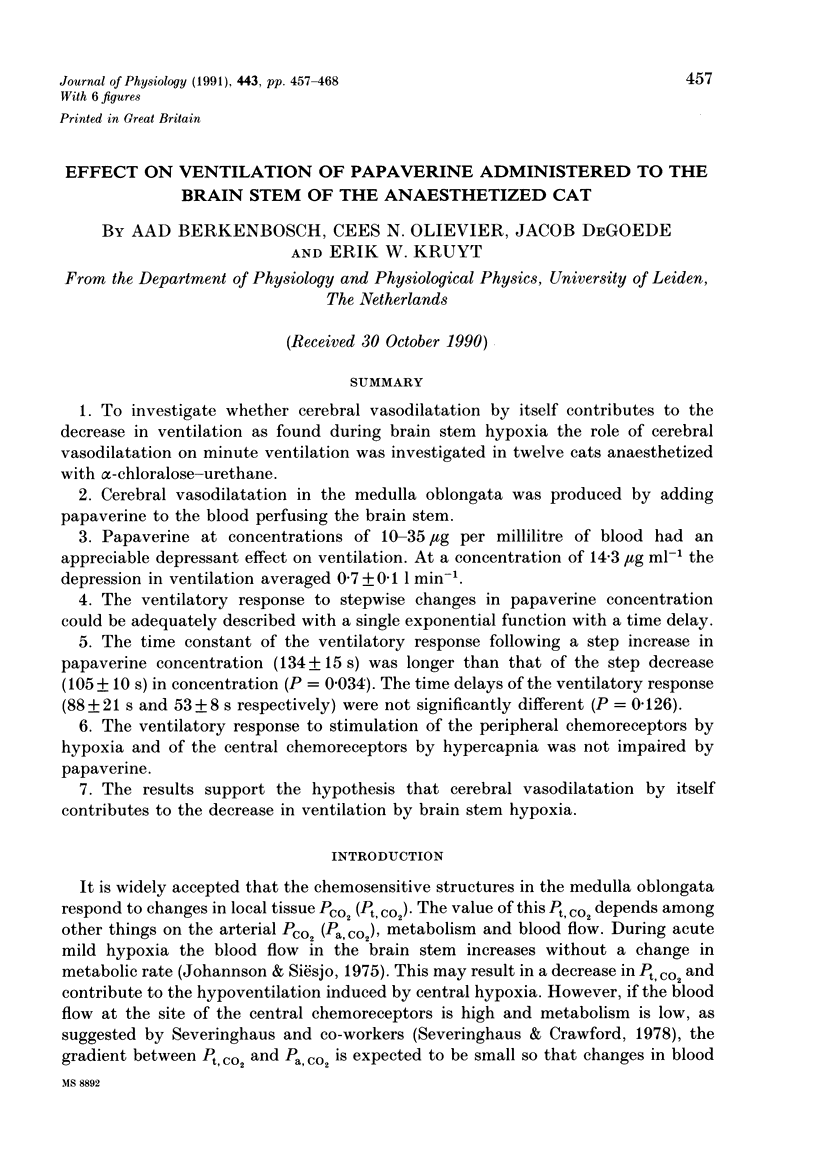
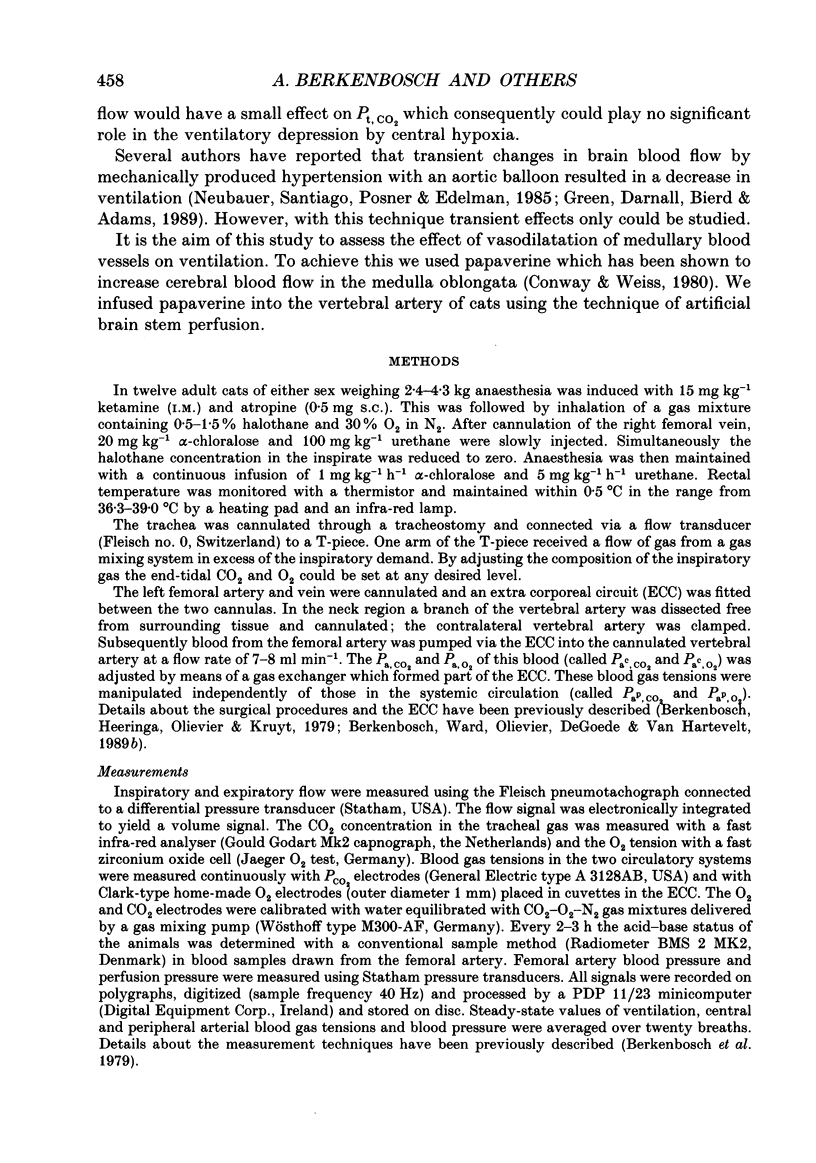
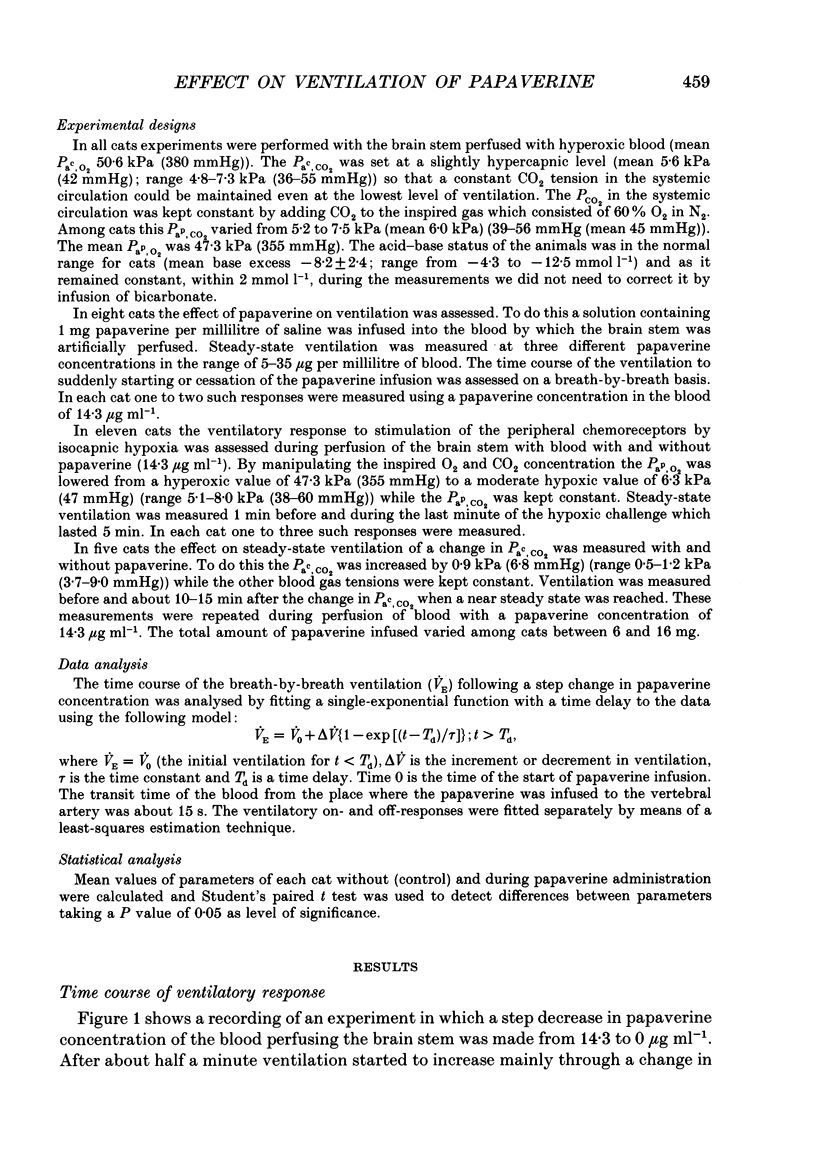
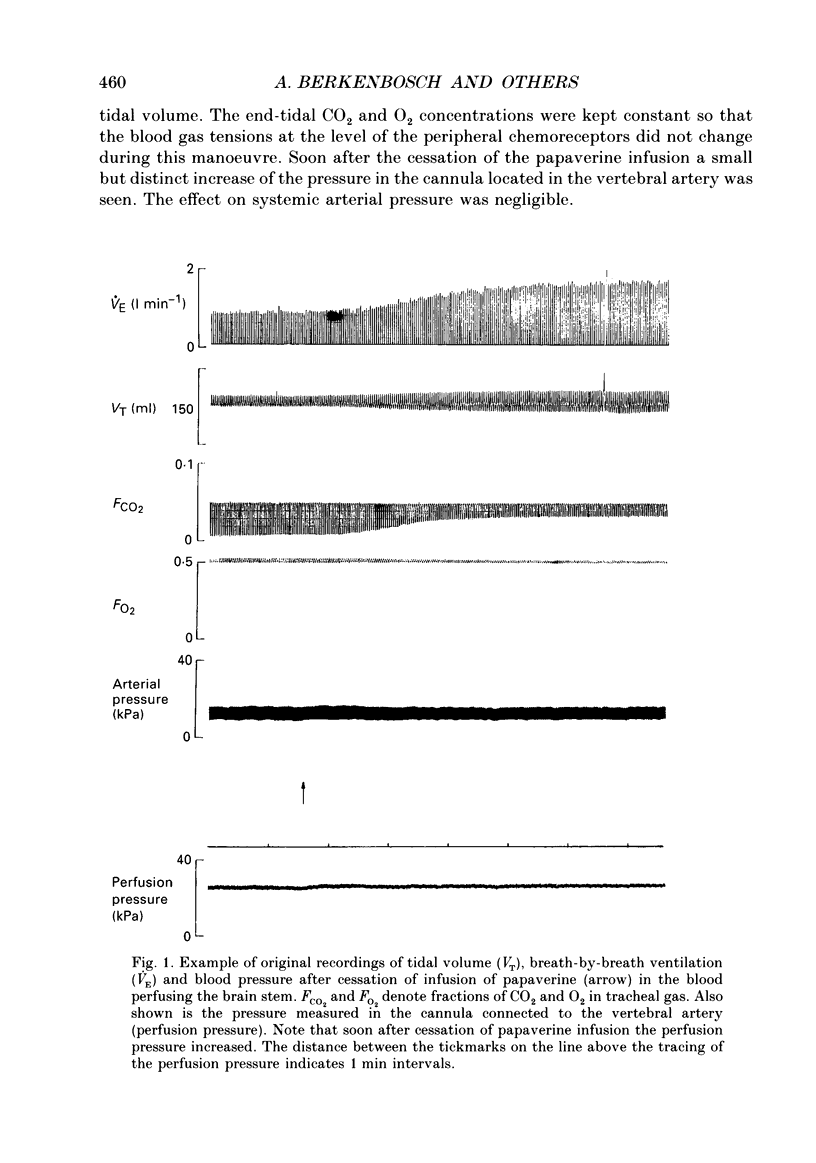
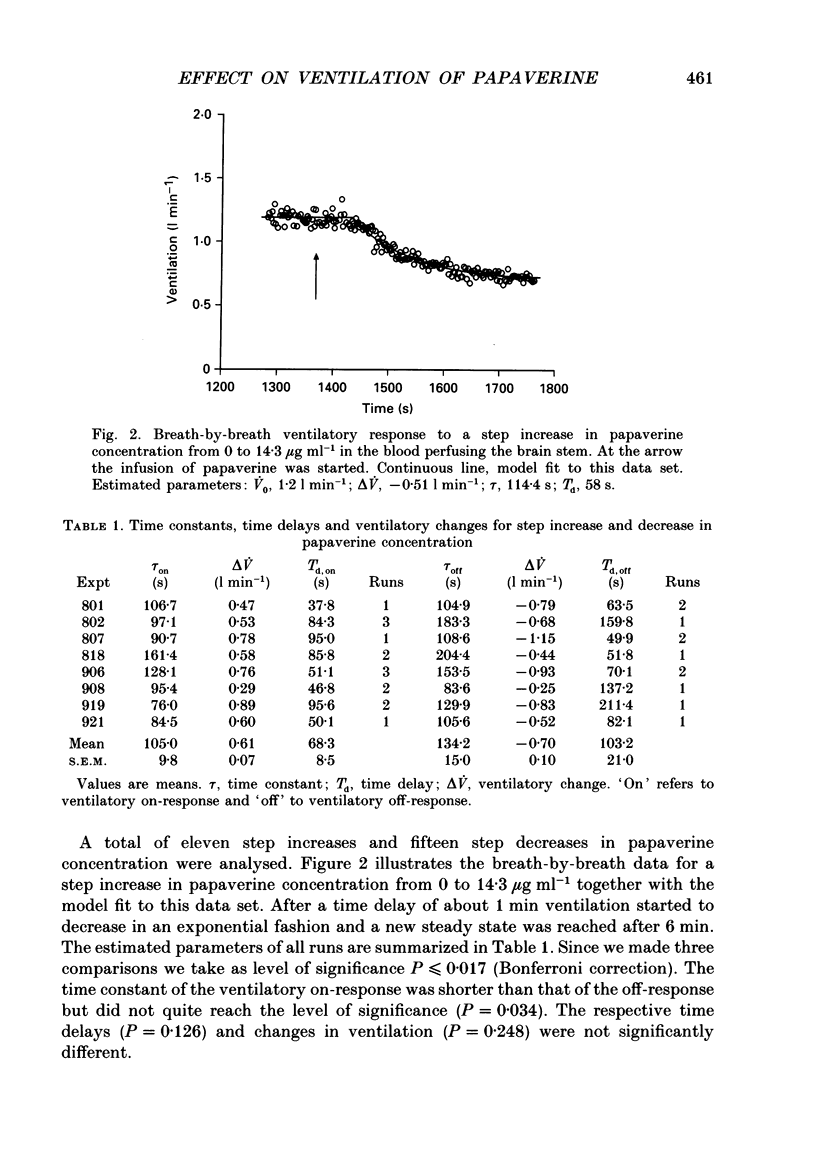
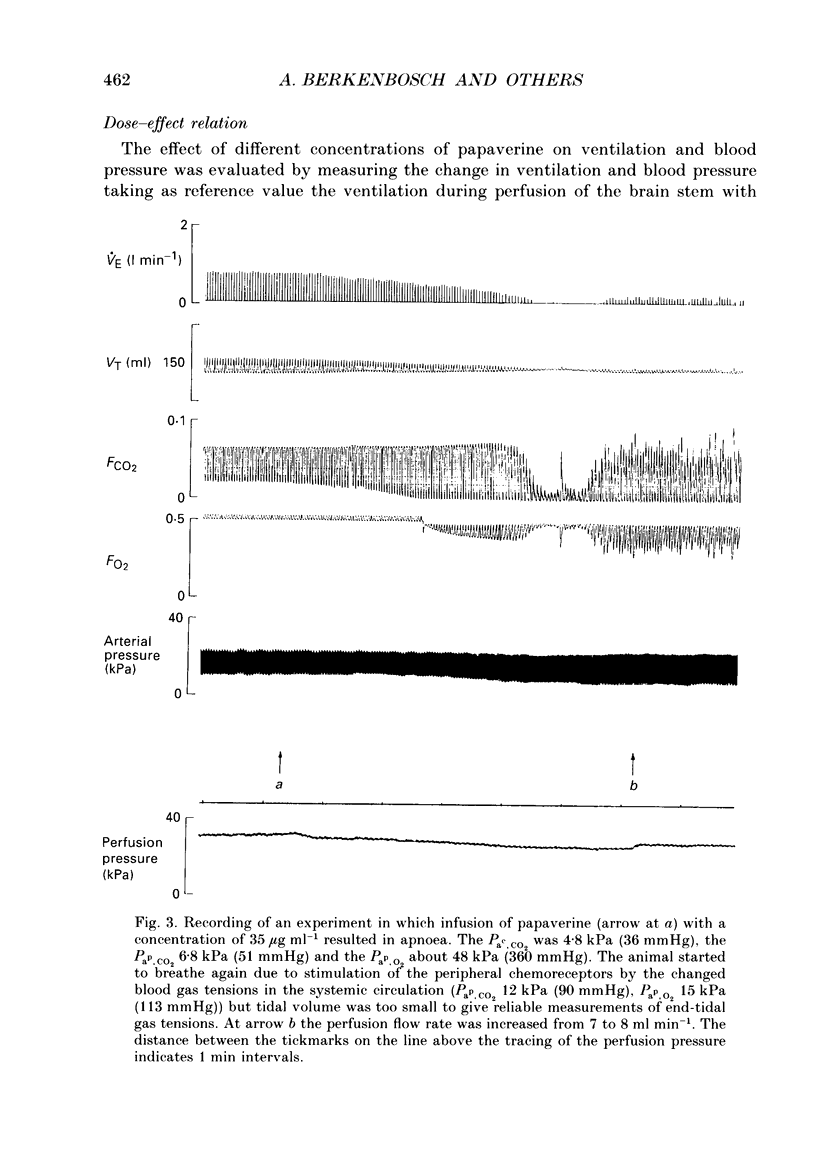
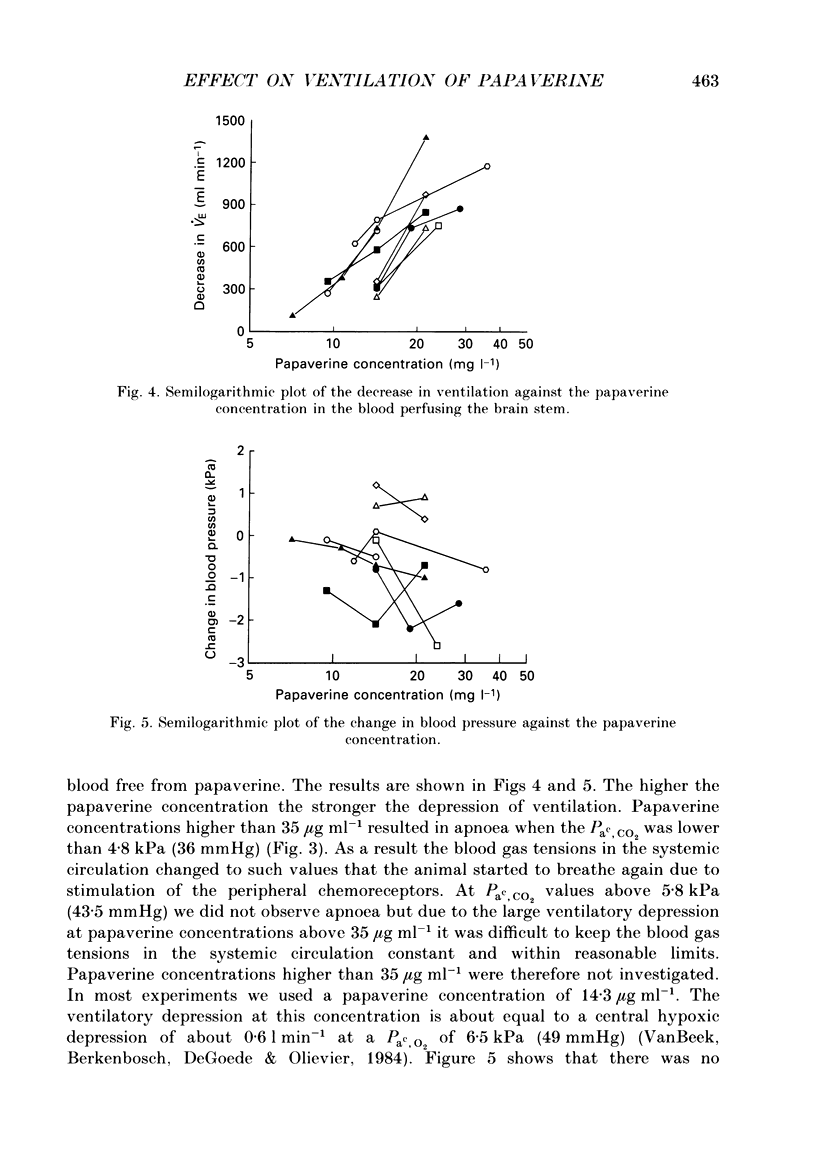
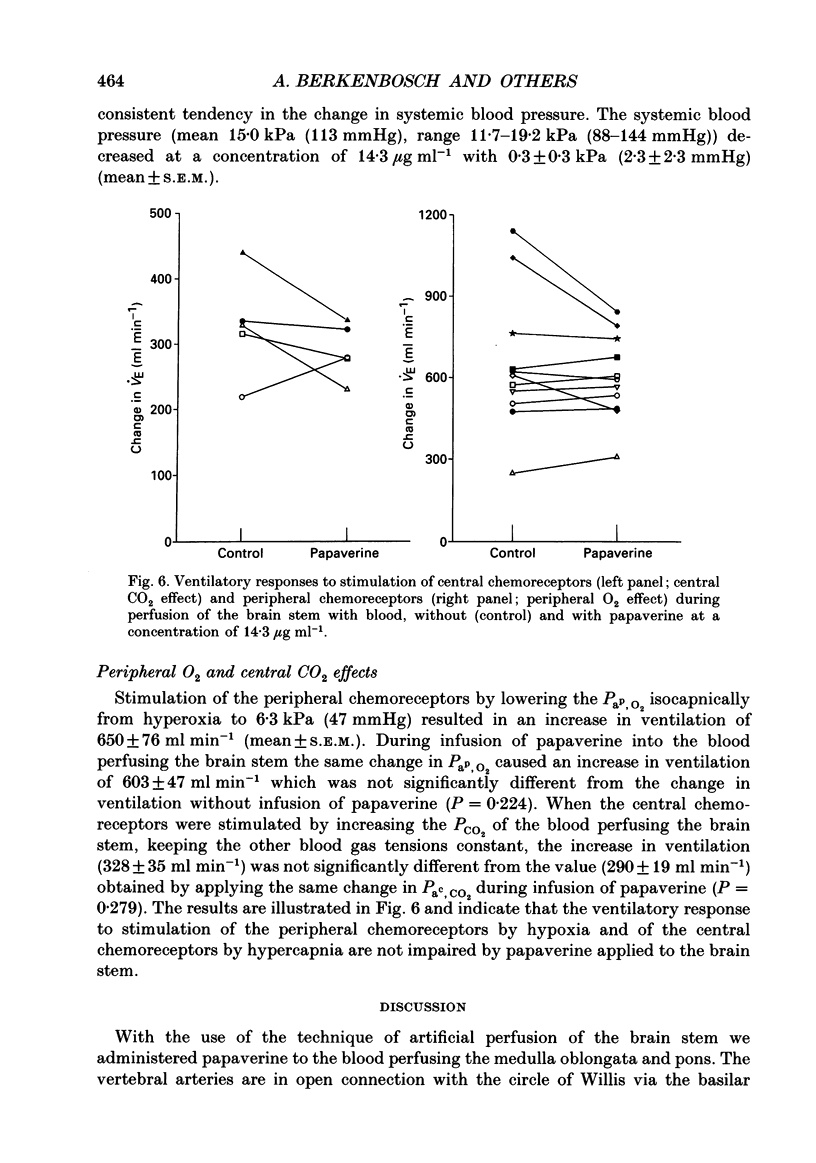

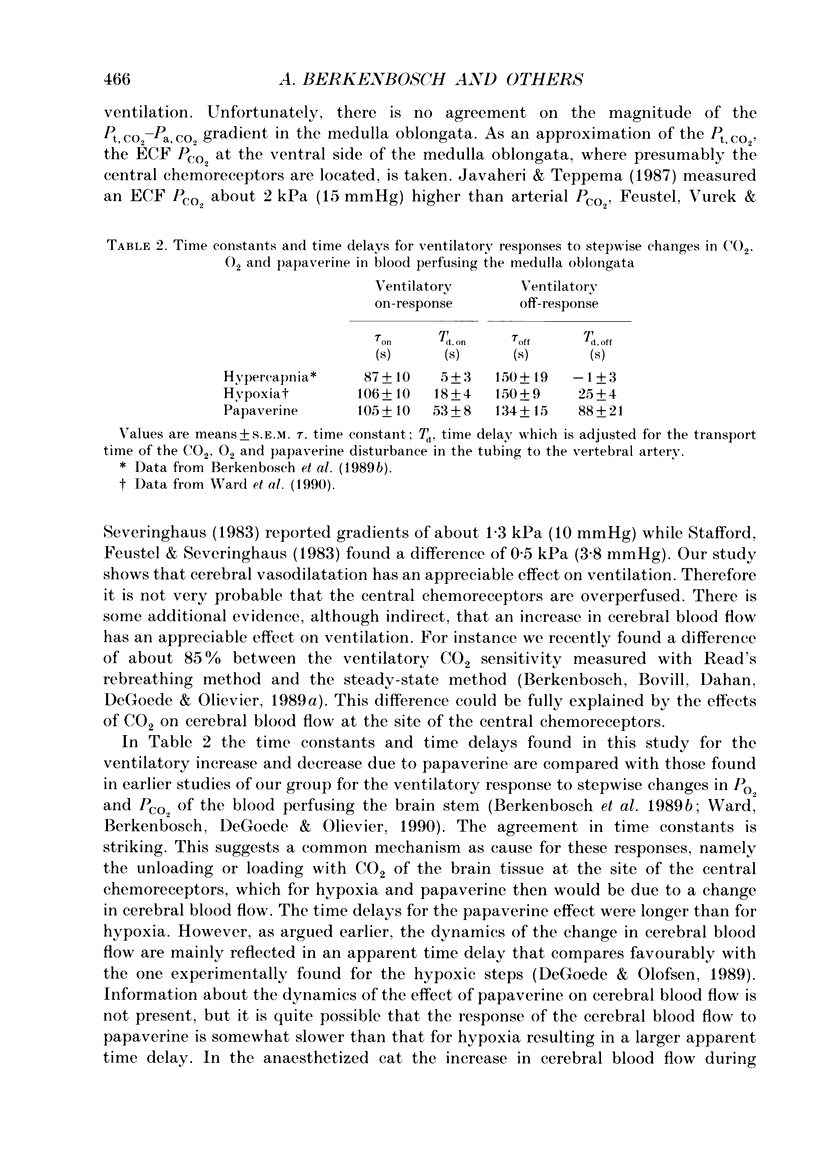
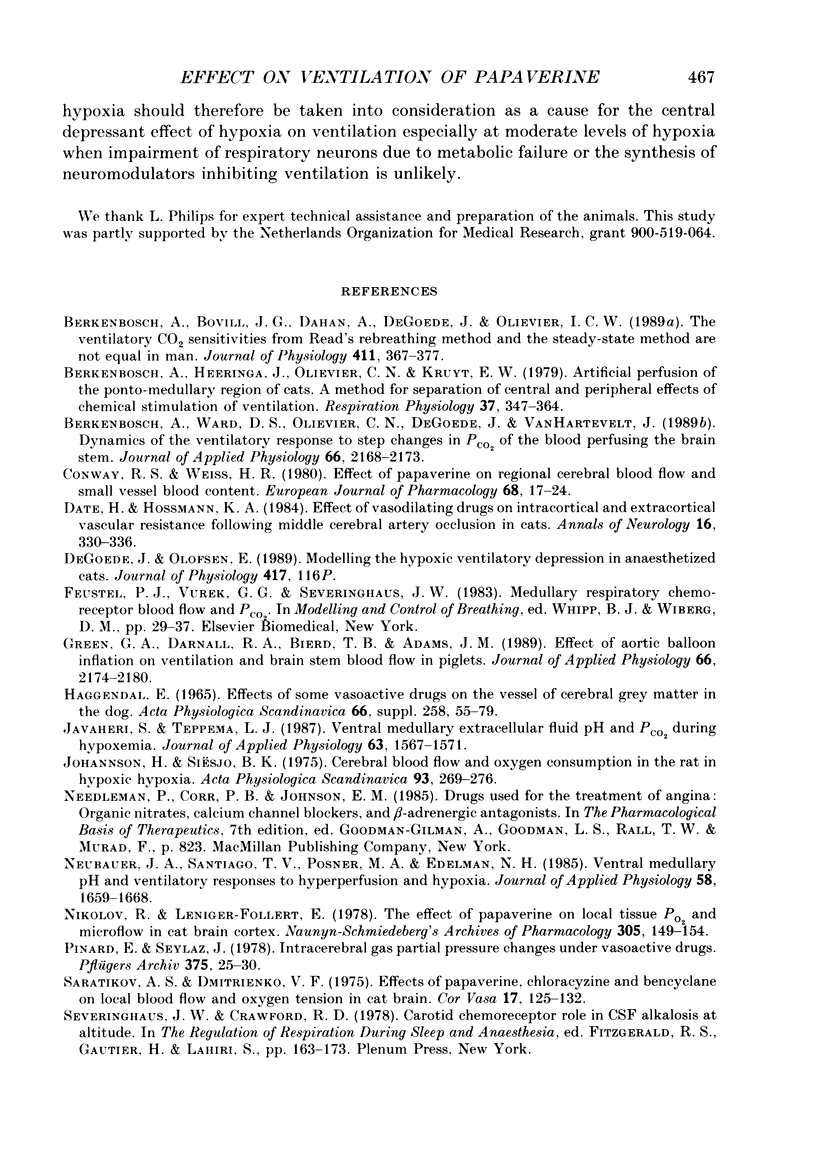
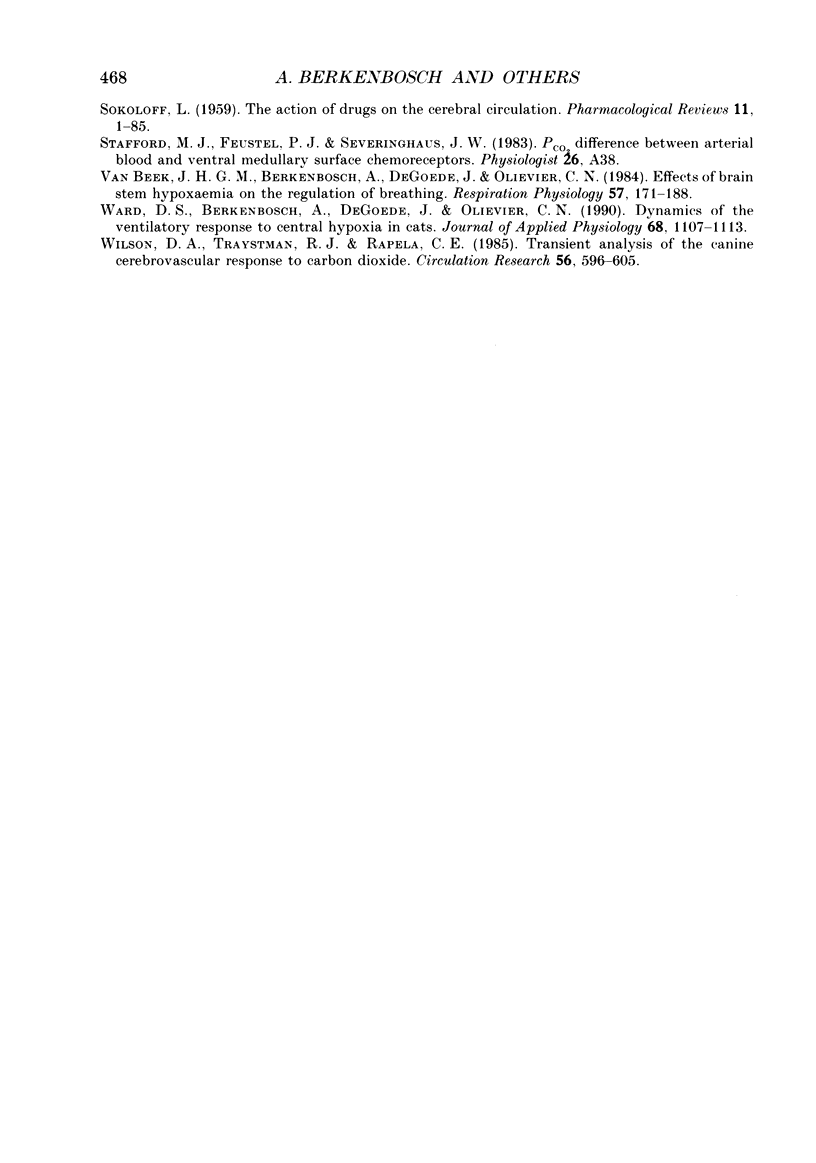
Selected References
These references are in PubMed. This may not be the complete list of references from this article.
- Berkenbosch A., Bovill J. G., Dahan A., DeGoede J., Olievier I. C. The ventilatory CO2 sensitivities from Read's rebreathing method and the steady-state method are not equal in man. J Physiol. 1989 Apr;411:367–377. doi: 10.1113/jphysiol.1989.sp017578. [DOI] [PMC free article] [PubMed] [Google Scholar]
- Berkenbosch A., Heeringa J., Olievier C. N., Kruyt E. W. Artificial perfusion of the ponto-medullary region of cats. A method for separation of central and peripheral effects of chemical stimulation of ventilation. Respir Physiol. 1979 Aug;37(3):347–364. doi: 10.1016/0034-5687(79)90081-1. [DOI] [PubMed] [Google Scholar]
- Berkenbosch A., Ward D. S., Olievier C. N., DeGoede J., VanHartevelt J. Dynamics of ventilatory response to step changes in PCO2 of blood perfusing the brain stem. J Appl Physiol (1985) 1989 May;66(5):2168–2173. doi: 10.1152/jappl.1989.66.5.2168. [DOI] [PubMed] [Google Scholar]
- Conway R. S., Weiss H. R. Effect of papaverine on regional cerebral blood flow and small vessel blood content. Eur J Pharmacol. 1980 Nov 7;68(1):17–24. doi: 10.1016/0014-2999(80)90055-2. [DOI] [PubMed] [Google Scholar]
- Date H., Hossmann K. A. Effect of vasodilating drugs on intracortical and extracortical vascular resistance following middle cerebral artery occlusion in cats. Ann Neurol. 1984 Sep;16(3):330–336. doi: 10.1002/ana.410160309. [DOI] [PubMed] [Google Scholar]
- Green G. A., Darnall R. A., Bierd T. B., Adams J. M. Effect of aortic balloon inflation on ventilation and brain stem blood flow in piglets. J Appl Physiol (1985) 1989 May;66(5):2174–2180. doi: 10.1152/jappl.1989.66.5.2174. [DOI] [PubMed] [Google Scholar]
- Häggendal E. Effects of some vasoactive drugs on the vessels of cerebral grey matter in the dog. Acta Physiol Scand Suppl. 1965;258:55–79. doi: 10.1111/j.1748-1716.1965.tb03235.x. [DOI] [PubMed] [Google Scholar]
- Javaheri S., Teppema L. J. Ventral medullary extracellular fluid pH and PCO2 during hypoxemia. J Appl Physiol (1985) 1987 Oct;63(4):1567–1571. doi: 10.1152/jappl.1987.63.4.1567. [DOI] [PubMed] [Google Scholar]
- Jóhannsson H., Siesjö B. K. Cerebral blood flow and oxygen consumption in the rat in hypoxic hypoxia. Acta Physiol Scand. 1975 Feb;93(2):269–276. doi: 10.1111/j.1748-1716.1975.tb05815.x. [DOI] [PubMed] [Google Scholar]
- Neubauer J. A., Santiago T. V., Posner M. A., Edelman N. H. Ventral medullary pH and ventilatory responses to hyperperfusion and hypoxia. J Appl Physiol (1985) 1985 May;58(5):1659–1668. doi: 10.1152/jappl.1985.58.5.1659. [DOI] [PubMed] [Google Scholar]
- Nikolov R., Leniger-Follert E. The effect of papaverine on local tissue PO2 and microflow in cat brain cortex. Naunyn Schmiedebergs Arch Pharmacol. 1978 Nov;305(2):149–154. doi: 10.1007/BF00508285. [DOI] [PubMed] [Google Scholar]
- Pinard E., Seylaz J. Intracerebral gas partial pressure changes under vasoactive drugs. A mass spectrometry study. Pflugers Arch. 1978 Jun 21;375(1):25–30. doi: 10.1007/BF00584144. [DOI] [PubMed] [Google Scholar]
- SOKOLOFF L. The action of drugs on the cerebral circulation. Pharmacol Rev. 1959 Mar;11(1):1–85. [PubMed] [Google Scholar]
- Saratikov A. S., Dmitrienko V. F. Effects of papaverine, chloracyzine, and bencyclane on local blood flow and oxygen tension in cat brain. Cor Vasa. 1975;17(2):125–132. [PubMed] [Google Scholar]
- Ward D. S., Berkenbosch A., DeGoede J., Olievier C. N. Dynamics of the ventilatory response to central hypoxia in cats. J Appl Physiol (1985) 1990 Mar;68(3):1107–1113. doi: 10.1152/jappl.1990.68.3.1107. [DOI] [PubMed] [Google Scholar]
- Wilson D. A., Traystman R. J., Rapela C. E. Transient analysis of the canine cerebrovascular response to carbon dioxide. Circ Res. 1985 Apr;56(4):596–605. doi: 10.1161/01.res.56.4.596. [DOI] [PubMed] [Google Scholar]
- van Beek J. H., Berkenbosch A., de Goede J., Olievier C. N. Effects of brain stem hypoxaemia on the regulation of breathing. Respir Physiol. 1984 Aug;57(2):171–188. doi: 10.1016/0034-5687(84)90091-4. [DOI] [PubMed] [Google Scholar]


